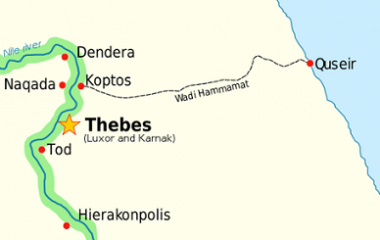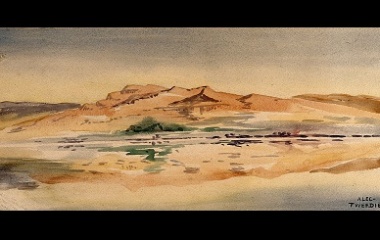Pharaohs once ruled the people, deserts and lush plains of Egypt. They worshipped their gods and built colossal temples to venerate them. The temple priests were tasked as vassals of the gods, but in the ancient land of Thebes, the priests grew even more powerful than their ruler and declared themselves Pharaohs!
What Is Thebes?
Thebes was an ancient Egyptian city, a powerful religious and secular center, and even the capital of Egypt during the New Kingdom Period (1570-1069 BC). At the height of its popularity, between 1353-1336 BC, Thebes was the largest city in the world. Sources claim the population may have reached 80 000 residents! The ancient name of the city, Wase or Wo’se, means the city of the was or city of the scepter. The names P-Amen, which translates as the city of Amun, and Nowe or Nuwe were also used.
Where Was Thebes Situated?
The ancient city was situated in the fourth nome (province) of Upper Egypt on either side of the Nile River, approximately 419 miles south of Cairo. The largest portion of Thebes was located on the east bank of the river, with the whole city covering 36 square miles. Today the modern city of Luxor is the site of many of Thebes’ principal ruins. The remains of the city, spanning the east and west bank of the Nile, are now a UNESCO world heritage site.
History
Sources claim Thebes had been in existence since the 4th dynasty and became an eminent city around 3200 BC due to the Cult of Amun and its popularity at the time. Thebes became a major center for worshipping Amun, a combination of earlier gods Atum and Ra. Amun formed part of the Theban Triad, consisting of Amun, Mut and Khons. Amun represented the sun; Mut (his wife) represented the sun’s rays and the all-seeing eye; and Khons was the destroyer of evil spirits and god of healing. A majestic temple called Karnak was built in Thebes, and was dedicated to the worship of the Triad. It was one of the largest religious structures ever built and still exists today, reflecting the grandeur of ancient Egypt.
The popularity of the Triad and their worship led directly to the increasing prosperity of Thebes. The priests of Amun eventually became so powerful that they took over the rule of Upper Egypt from the Pharaoh between 1069 and 525 BC!
Old and Middle Kingdom
In the Old Kingdom, from 2316-2181 BC, the Pharaohs resided in Memphis, the ancient capital of Lower Egypt, and Thebes was merely a small trading post. During the First Intermediate Period and Middle Kingdom, from 2181-2040 BC, the rulers of Egypt moved from Memphis to Herakleopolis. The magistrates at Thebes had grown tired of their rulers’ continued ineffectualness by then and decided to challenge their power. They waged war on the Herakleopolis Kings, resulting in a Theban King finally ruling in 2055 BC! This was a major turning point as the Theban gods then became supreme to the gods of Lower Egypt and Thebes rose exponentially in popularity. Work began on the resplendent temple of Karnak during this period, mirroring the new prosperity of the area.
The Hyksos Period and New Kingdom
The city continued to grow in the Second Intermediate Period (1640-1532 BC). The 15th dynasty was ushered in when an immigrant group called the Hyksos entered Egypt. Certain sources cite the immigrants as having Asian lineage, but others say the word Hyksos more likely referred to their ruler rather than an ethnic group. The Hyksos controlled Egypt by 1650 BC and were viewed as oppressive by the locals even though they introduced new technology like the chariot. The Thebans and Hyksos developed a truce when the foreign rulers began to encroach on Theban territory. The truce was unfortunately broken when Hyksos’s ruler, Apophis, insulted Ta’O of Thebes. The Theban armies then attacked the Hyksos cities and drove the immigrants out of Egypt. During the New Kingdom the country stabilized and began to prosper once again, especially Thebes, which had become its capital. Great palaces and temples were built, each one outdoing the next, and lush gardens lined the river banks of the new center.
Amarna Period
The priests of Amun at Thebes soon owned more land and more wealth than the Pharaoh. Amenhotep IV (or Akhenaten as he was later called), the Pharaoh at the time, perhaps concerned about his tenuous power over his people, suddenly adopted monotheism and proclaimed Aten, the sun disk, as the supreme deity. This was a major blow to Thebes, and led to the eventual closure of the Amun temples. When his son Tutankhaten came into power after his father’s death, he changed his name from Tutankhaten (living image of Aten) to Tutankhamun (living image of Amun) and restored Thebes back to its splendor again, with the old temples and gods no longer banned.
The Decline of Thebes
Under Ramessids II, Thebes began to decline as the capital was moved to Avaris. Ramessids II built a splendid palace in Avaris, perhaps because there was little chance of a palace – or him – standing out in Thebes. The priests of Amun nonetheless still grew stronger. Outside of the Pharaoh’s gaze, they continued to acquire more lands until they declared themselves Pharaohs of Thebes by the end of the period! In the 7th century BC, the Nubian pharaoh, Tatanani, moved the capital back to Thebes. Ultimately, Thebes was sacked by the Assyrian King and his army. The Assyrians forced the Egyptians to rebuild Thebes as punishment for their resistance. The city recovered partly, but was then annihilated by the Roman army in the first century AD.
Major Archeological Works
The site of Thebes holds a wealth of ancient artefacts and links to the wondrous civilization of ancient Egypt. On the eastern bank we find Karnak, the massive temple of Amun. Built over 2000 years ago, it remains one of the largest religious structures in the world today. It has 10 pylons, massive stone structures at the temple entrances; the Hypostyle Hall, a 54 000-square-feet hall with 12 columns reaching up 80 feet; and numerous obelisks. Further north on the same bank we find Luxor, another temple, and this time not dedicated to a god, but rather the rejuvenation of kingship. It was possibly the place where the Pharaohs were crowned.
On the western bank we find the well-known Valley of the Kings, the burial site for the Pharaohs and noble men for a period of over 500 years. The Tomb of Tutankhamun was found there most recently. The Valley of the Queens is located further south and was called Ta-Set-Neferu, which meant the place of beauty. The wives of Pharaohs, including the renowned Nefertiti, were buried in the valley.
The men holding both secular and religious positions in Thebes and greater Egypt lusted for the same thing: power. As in modern times, it was not a quenchable thirst and led to the rise and fall of personal position, cities and even the whole country. Though many innocent people would have suffered by their actions, they did leave behind a legacy which provides a deep and remarkable insight into the mysteries of the Egyptian civilization.











nice!